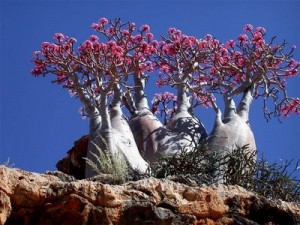Is it a Desert Rose?
 Q. Can you provide me any information on desert rose (Euphorbia tactea)?
Q. Can you provide me any information on desert rose (Euphorbia tactea)?
A. There is no such plant as Euphorbia tactea and desert rose is the common name of Adenium obesum.
We both learned something and actually the plant in the photo you sent me is not an ordinary E. lactea. What it looks like to me is a grafted, man-made concoction, created for sale as an eye-catching houseplant. It is not a natural plant that nature created in that exact form. What it looks like is a Euphorbia lactea ‘Cristata’ grafted onto an erect (uncrested) euphorbia base. This technique is often used also with cacti and can create a change in the color of the plant that is grafted on top, which is exactly what appears to be the case with the plant you have. But regardless of the exact origin of your plant, the correct directions for growing it are given below. Watch out when handling it. The sap of this plant irritates skin worse than that of some other euphorbias.
With that photograph of the plant you sent me we discovered what it is, so here is the botanical information and cultural requirements of this plant:
Euphorbia lactea is a euphorbia native to India with 3 or 4 angled branches that are deeply scalloped with black spines. It is used medicinally in India as a hot jam to treat rheumatism. All plant parts are poisonous, especially the white, milky sap which can irritate skin, eyes and mouth. Euphorbia lactea need full sun to partial shade and warm temperatures. Grow in soil mix consisting of equal parts loam and sand. Allow the root zone to completely dry thoroughly between waterings. In winter allow the plant to go completely dry, irrigating only once during the winter months. Over-watering, especially during winter is the best way to kill this plant. Euphorbia lactea “Cristata” is an intricately monstrous form with fan-shaped crested branches forming a snaky ridge or crowded cluster. The crested form is often used in grafting to create a man-made plant.

